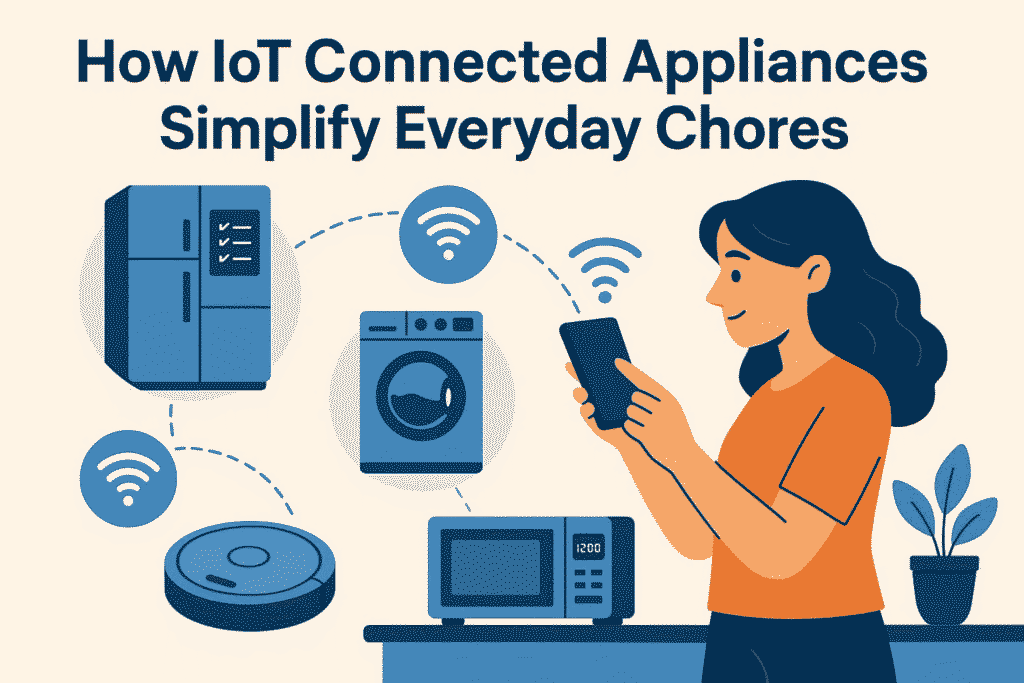
Table of Contents
It’s a familiar scene for many: you stumble into the kitchen, bleary-eyed, only to be greeted by the silent accusation of last night’s dinner dishes. The laundry basket in the hallway has seemingly reproduced overnight, and the thought of planning dinner after a long day feels like a Herculean task. For generations, managing a household has been a relentless cycle of mundane, time-consuming chores. But a quiet revolution is underway within our very walls, promising not a future of robot butlers, but something far more practical and integrated. The Internet of Things (IoT) is transforming our homes, and at the heart of this change are intelligent, connected appliances that are actively simplifying our daily grind, giving us back our most precious resource: time.
Gone are the days when “smart” meant a television with internet access. Today, IoT refers to the vast network of physical objects—from refrigerators to washing machines—embedded with sensors, software, and connectivity that allows them to collect, exchange, and act on data. These aren’t just novelty gadgets; they are sophisticated tools for home management, designed to reduce both the mental and physical load of maintaining our living spaces. This article explores how IoT connected appliances are weaving a fabric of convenience and efficiency throughout the modern home, turning tedious chores into automated, manageable tasks.
The Kitchen: Where Cooking Meets Computing
The kitchen, long the command center of the home, is experiencing the most profound transformation. It’s evolving from a space of manual labor into a hub of intelligent assistance.
The Smart Refrigerator: Your Kitchen’s Proactive Pantry Manager
Imagine peering into your fridge from the middle of the grocery store aisle. With internal cameras, this is now a reality. No more trying to mentally inventory what you’re out of milk for. But the modern smart fridge does far more than just show you its contents.
These appliances act as the brain of your kitchen. Through internal sensors and sometimes manual logging via touchscreens, they can track inventory. Forgot when you bought that block of cheese? The fridge can alert you as it approaches its expiration date. This dramatically reduces food waste and saves money. Furthermore, this inventory data integrates with recipe apps, which can suggest meals based on the exact ingredients you have on hand. Before you’ve even decided what’s for dinner, your kitchen is already helping you plan. Many models also feature family hubs—shared digital calendars, note-taking apps, and even streaming entertainment—making the refrigerator the true communication center of the home.
The Intelligent Oven & Cooktop: Precision Cooking at Your Fingertips
The anxiety of wondering if you left the oven on is now obsolete. IoT-enabled ovens allow for remote monitoring and control via a smartphone app. You can preheat the oven on your drive home from work, ensuring it’s ready to go the moment you walk in the door. This simple feature can shave 15-20 minutes off meal preparation time.
Beyond convenience, these ovens offer unparalleled precision. With recipe-guided cooking, the oven can automatically set itself to the correct temperature and timer for the dish you’ve selected, eliminating guesswork and improving outcomes for novice and expert cooks alike. Voice control integration with assistants like Google Assistant or Amazon Alexa adds another layer of hands-free convenience—you can preheat, set a timer, or check the status without lifting a finger, a boon when your hands are covered in flour.
The Self-Maintaining Dishwasher: The End of the Sink Pile-Up
The humble dishwasher has become a paragon of efficiency. With connectivity, it can send a notification to your phone the moment a cycle is complete, preventing dishes from sitting in steam and getting musty. More importantly, it can send proactive alerts when rinse aid or detergent is running low, and some high-end models are even beginning to integrate with subscription services to reorder these supplies automatically.
From a maintenance perspective, these smart dishwashers can run self-diagnostic checks. Instead of a mysterious error code, you might receive a notification stating, “The spray arm is obstructed,” or “The water inlet valve is faulty.” This empowers homeowners with specific information before a service call is even made, saving time, frustration, and potentially costly diagnostic fees.
The Laundry Room: Effortless Cleaning from Start to Finish
Laundry is a chore notorious for its multi-step process and its ability to consume large blocks of time. IoT is streamlining this process from wash to fold.
Smart Washers & Dryers: Customized Fabric Care
The core benefit of connected laundry appliances is remote control and monitoring. You can start a wash cycle from anywhere, pause it if you need to add a forgotten sock, or receive an alert the moment the cycle ends. This is a game-changer for preventing laundry from sitting damp in the machine and developing mildew smells.
These appliances are also becoming incredibly intelligent. Using sensors and AI, they can detect the size and fabric type of a load and automatically recommend or select the optimal cycle, water temperature, and spin speed. This not only ensures your clothes are treated with the best possible care but also conserves water and energy. For dryers, the precision is even more critical. They can sense moisture levels and automatically shut off when clothes are dry, protecting delicate fabrics from heat damage and saving significant energy compared to a standard timed cycle.
The Vision of a Fully Automated Laundry Process
While still emerging, the concept of a fully hands-off laundry system is taking shape. Some models now feature integration with smart scales and detergent dispensers that auto-dose the perfect amount of soap. The next logical step—seamless communication between washer and dryer, where the dryer automatically selects a setting based on the wash cycle just completed—is already appearing in integrated laundry pairs, creating a truly continuous, automated workflow.
Whole-Home Cleaning & Maintenance
The reach of IoT extends beyond specific rooms, tackling the general upkeep of the entire home with automated systems that work in the background.
The Robot Vacuum & Mop: The Ultimate Set-and-Forget Appliance
Perhaps the most visible and widely adopted smart home appliance, the robot vacuum, embodies the principle of automated chore management. You can schedule cleanings for specific times, ensuring you return to a freshly vacuumed home every day without any active effort. Modern versions have moved far beyond random bouncing.
With LiDAR and camera-based smart mapping, these robots navigate your home with remarkable efficiency, creating and remembering floor plans. You can designate “no-go” zones in an app to keep them away from pet bowls or delicate furniture, and even target specific rooms for a quick clean. The latest generation takes it a step further with self-emptying bases that hold weeks of dirt, and self-washing mop pads that clean themselves during a cycle. This transforms a weekly chore into a task that requires attention only once a month, reclaiming hours of personal time.
Climate & Air Quality Control: An Invisible Guardian
While not a “chore” in the traditional sense, maintaining a comfortable and healthy home environment is a constant responsibility. Smart thermostats like the Nest or Ecobee learn your schedule and preferences over time, automatically adjusting the temperature for energy savings when you’re away and comfort when you’re home. The result is a lower utility bill and a home that always feels right, without you ever touching a dial.
Similarly, smart air purifiers and humidity monitors continuously scan your indoor environment. They can detect a rise in pollen, dust, or VOCs (Volatile Organic Compounds) and automatically ramp up to clear the air, or notify you if humidity levels are conducive to mold growth. This proactive management of the home’s atmosphere is a form of maintenance that was previously impossible, contributing to both the well-being of the residents and the longevity of the home itself.
The “Invisible” Benefits: Saving More Than Just Time
The advantages of IoT appliances extend far beyond the obvious convenience, delivering profound benefits that impact our wallets, security, and overall quality of life.
Energy & Cost Efficiency: The Green and Lean Home
The intelligence of these appliances directly translates to resource conservation. A smart dishwasher can be scheduled to run in the middle of the night during off-peak electricity hours. A smart thermostat can learn to lower the heat when you’re at work, saving a significant amount on heating and cooling bills. Washing machines that auto-dose detergent prevent waste, and dryers that shut off at the perfect moment avoid unnecessary energy consumption. Over the course of a year, the cumulative savings on water, gas, and electricity can be substantial, helping to offset the initial higher investment.
Peace of Mind & Security: The Always-On Home Guardian
The ability to monitor and control your home from anywhere provides an unparalleled sense of security. Did you rush out the door and forget to turn off the iron (or more critically, the oven)? A quick glance at your phone can confirm its status, and a single tap can switch it off, preventing a potential disaster.
Furthermore, you can use these appliances to enhance home security while on vacation. By scheduling lights, a robot vacuum, and even the occasional dishwasher cycle, you can create the appearance of an occupied home, deterring potential intruders in a way that simple timer-based lights never could.
Accessibility & Aging in Place: Empowering Independence
This is perhaps the most impactful, yet often overlooked, benefit. For the elderly or individuals with disabilities, IoT appliances can be life-changing. Voice-controlled ovens and washing machines make them accessible to those with limited mobility or dexterity. Remote monitoring allows family caregivers to check if an elderly parent has started their laundry or made dinner, providing reassurance without intrusion. This technology empowers a growing demographic to maintain their independence and live safely in their own homes for longer.
Considerations Before You Connect
The connected home is not without its challenges, and it’s important to be an informed consumer before diving in.
- The Initial Investment: Smart appliances typically carry a premium price tag compared to their traditional counterparts. It’s crucial to weigh the long-term benefits in time and energy savings against this upfront cost.
- The Ecosystem & Compatibility: The “smart” experience can be frustrating if devices don’t work together. Before purchasing, check if an appliance is compatible with the smart home platform you use, be it Google Home, Amazon Alexa, or Apple HomeKit. A unified ecosystem provides a smoother, more integrated experience.
- Data Privacy & Security: Any device connected to the internet is a potential entry point for data collection or cyber threats. It is essential to secure your home Wi-Fi network with a strong password, regularly update appliance firmware, and understand the privacy policy of the manufacturer—what data is being collected, how it is used, and who it is shared with.
Conclusion: Reclaiming Your Time and Mental Space
The revolution ushered in by IoT-connected appliances is not about laziness; it’s about liberation. It’s about systematically eliminating the small, repetitive tasks that cumulatively create a significant mental and physical burden—what psychologists often refer to as “cognitive load.” By automating the monitoring of our pantry, the cleaning of our floors, the washing of our clothes, and the climate of our homes, this technology is freeing up cognitive bandwidth and hours of time each week.
This newfound time can be redirected towards what truly matters: connecting with family, pursuing hobbies, relaxing, or simply enjoying a moment of quiet. The smart home, therefore, is not a cold, futuristic concept. It is a practical, evolving environment designed to serve us better. As artificial intelligence and machine learning continue to advance, these appliances will become even more intuitive, moving from responding to commands to anticipating our needs. The dream of a home that truly maintains itself is no longer science fiction; it is, piece by connected piece, becoming our new reality.
